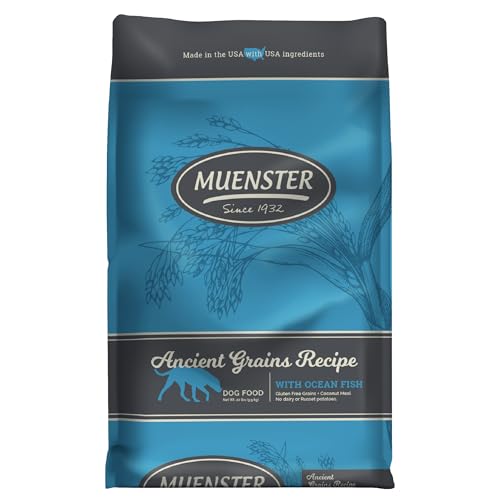Goldendoodle Health Issues: What Do Most Goldendoodles Die From & How To Help!?
Goldendoodles are a cross between a purebred Golden Retriever and a Poodle, and their intelligence, friendly nature, and affection make them a favorite among dog owners. Given the breed is a crossbreed (hybrid), their traits echo both breeds, combining the best of two or more breeds. However, genetics can also create the potential for developing hereditary genetic health problems from the parent breeds.

What are the most common Goldendoodle health issues?
Goldendoodles are prone to developing the same health conditions common to both Golden Retrievers and Poodles. The most common diseases that Goldendoodles get are hip dysplasia, sebaceous adenitis (a skin disease), sub valvular aortic stenosis (a heart condition), Addison’s disease, and cataracts.
In this article, I will discuss the most common diseases Goldendoodles are prone to and how to prevent them, if possible. Some of these will affect your Goldendoodle’s lifespan, while others will affect their quality of life.
Initially, one of the best steps you can take when looking for a Goldendoodle is to be sure you locate a good and reputable breeder. A good breeder will be able to provide you with all the health certifications necessary to screen out health problems (as much as possible).
Having appropriate genetic health testing is key to decreasing your chances of bringing home a puppy that could pose a risk for future health issues.
The Most Common Non-Fatal Goldendoodle Health Issues
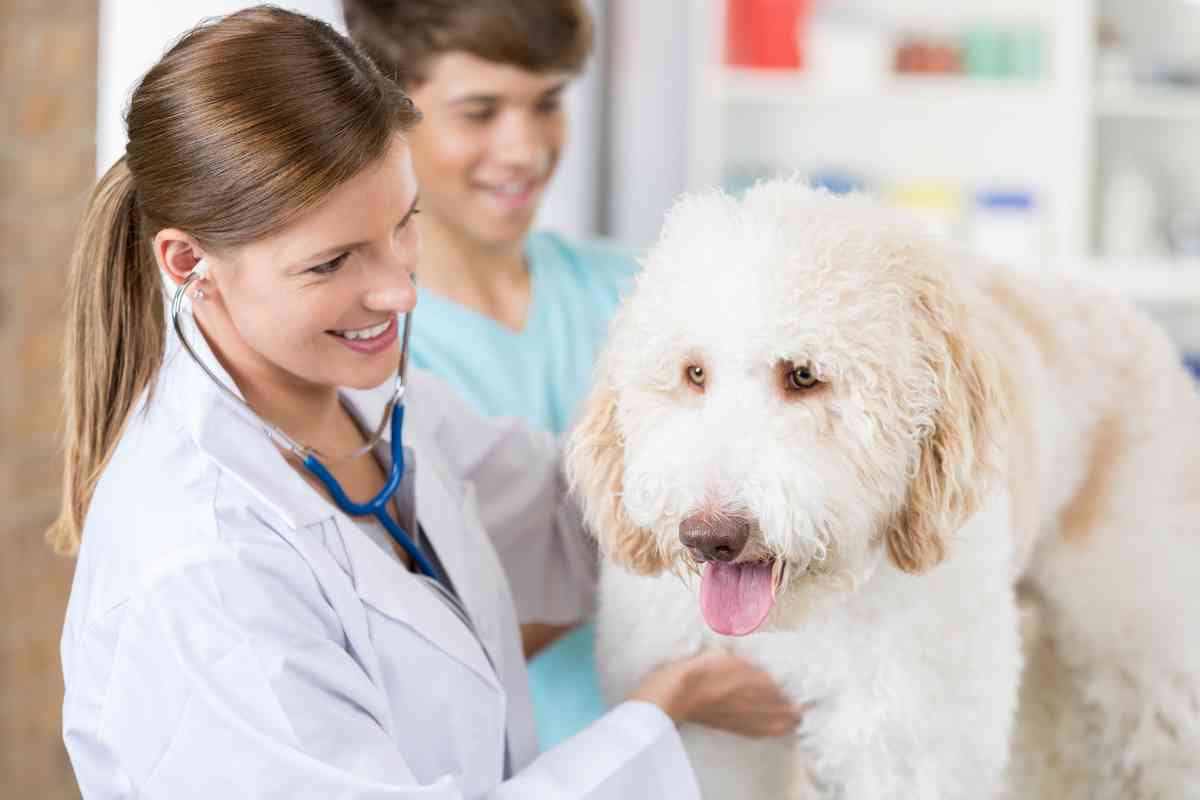
Hip Dysplasia
Regarding orthopedic diseases, Hip Dysplasia is more common in large dogs than medium-sized or mini Goldendoodles. This is a genetic disease causing mild to severe changes to the inner workings of the Goldendoodle’s hip joint.
As the name suggests, hip dysplasia is a problem that involves the hip bone not properly fitting into the socket, which results in the bones grinding on one another. This is a common issue that comes from the Golden Retriever parent breed.
In more technical terms, it is when the femoral head (the ball portion of the femur) and the acetabulum (the pelvis’s hip socket) align poorly, resulting in the inability to provide the smooth movement a pet requires for a lifetime of weight-bearing and normal wear and tear.
When a Goldendoodle suffers from hip dysplasia, the “ball” portion does not sit within the hip socket but rather rests on the edge of the hip socket. Or, the socket itself is too shallow to hold the hip in place, resulting in bone-on-bone contact producing inflammation (heat).
The body, adapting to the situation, produces extra little bits of bone around the joint (attempting to stabilize it), producing what is commonly referred to as arthritis.
Over time, this condition continues to become more painful and severe for your dog.
Golden Doodle hip dysplasia can be a very expensive course of treatment (it can range from the low side of $1,500 to over $12,000), affecting one or both hips simultaneously.
Surprisingly, many Goldendoodle hip dysplasia sufferers do not exhibit any symptoms or appear to be in pain, resulting in crippling arthritis as they age.
Since it is not always obvious to the pet owner their pet is suffering from hip dysplasia, it is important to ensure your dog receives regular checkups with their veterinarian.
If your dog is displaying any symptoms of the disease, you may notice some of the following conditions.
- bunny hopping
- running with both hind legs together
- short strides of the hind legs
- having trouble jumping up
- muscle atrophy on the hind legs
- sore and slow getting up (especially after exercise)
- very sensitive and protective of the rear end
But how can we prevent this from happening to our dog or ensure we catch this disease in its early stages? Practicing due diligence when searching for a Goldendoodle puppy can play a large part in the health of your new family member.
Be sure to do your research on the breeder and the puppy’s parents, make sure the correct genetic testing is done, as well as request evidence from the breeder the parents have hip certifications from the Orthopedic Foundation for Animals.
Due diligence when looking to purchase a puppy is key, but there are other actions you, as an owner, can take to help lessen the occurrence of hip dysplasia in your pet.
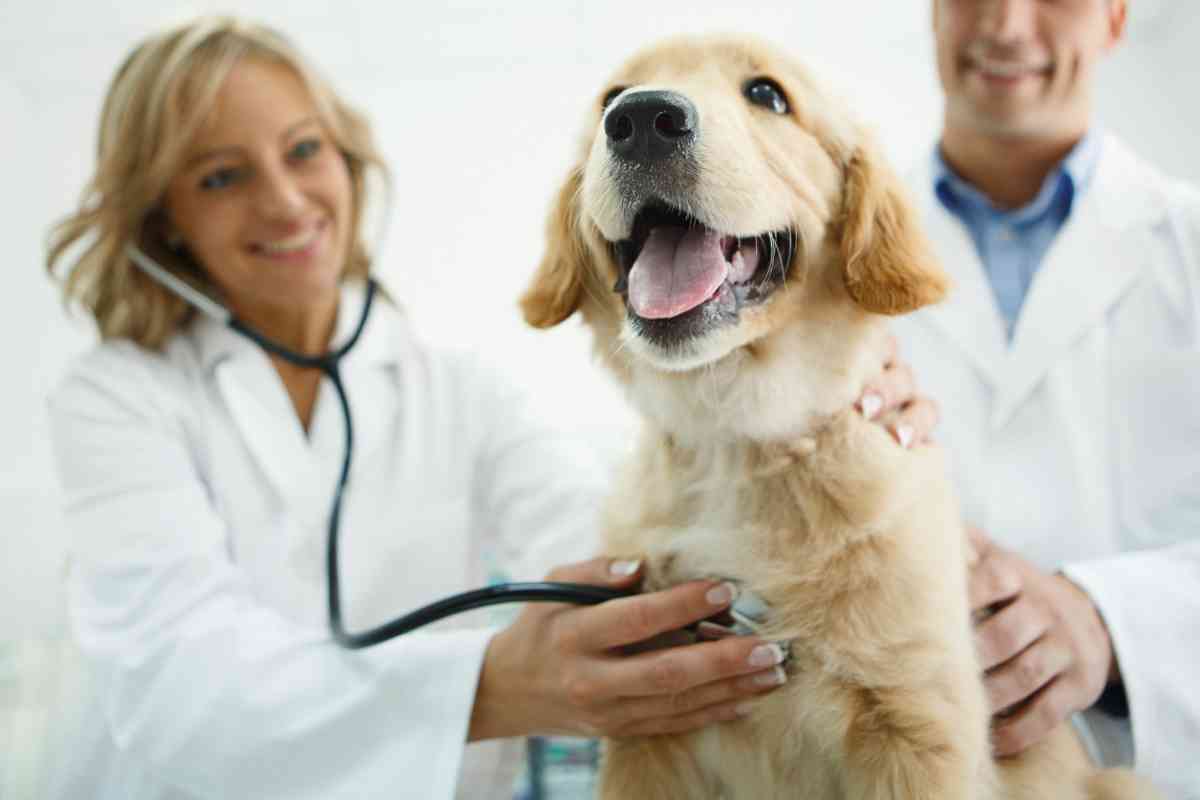
What Causes Hip Dysplasia in Goldendoodles?
One of the most common causes of hip dysplasia seen in Golden Doodles is genetics, but some other causes include improper nutrition, being overweight, and too little or too much exercise.
How do you prevent hip dysplasia?
Young Goldendoodle puppies should have their hips evaluated at 2 to 3 months of age. These x rays can be sent off to a boarded veterinary radiologist to be evaluated to see if your Goldendoodle is predisposed to developing hip dysplasia developing in the future.
Supply your Goldendoodle with a balanced diet, one that is not high in carbohydrates, fat and excessive dietary calcium like this one:
Additionally, studies suggest overfeeding your Goldendoodle as a puppy can be harmful, when feeding your puppy, look for puppy foods with comparatively lower calcium content and feed according to your pup’s activity level.
Further, it is important to be aware of over-exercising your Golden Doodle (and other larger breed of dogs) can lead to injury contributing to hip incongruence.
Taking your dog to the vet for a comprehensive evaluation allows for a better diagnosis with a simple X-ray (revealing the conformation of the hips and identifying arthritis if present) and, if required, radiographs, which are essential in determining the presence of dysplasia or any other problems with your pet’s hips.
It is important to note the earlier this condition is detected, the better for treatment and the possibility of slowing the progression of the condition.
How can you help your Goldendoodle with Pain from Hip Dysplasia
Non-Steroidal Anti-inflammatory Drugs (NSAIDs) are prescribed to decrease the pain and inflammation in your Goldendoodle’s joints.
Surgery options for Hip Dysplasia in Goldendoodles
There are 4 different surgical options that your vet can do to help with hip dysplasia in your Goldendoodle. In puppies, there are two procedures that can be done depending on the age of your Goldendoodle.
- A Juvenile Pubic Symphysiodesis (JPS) surgery done in puppies under 4 months of age. This surgery causes the pubic symphysis or the tissue between both sides of your dog’s pelvis to fuse together earlier. This fusion will change the sturcture of the pelvis and will increase the coverage of the head of the femur in the hip joint of your Goldendoodle.
- Double or Triple Pelvic Osteotomy (DPO/TPO) surgery is done in puppies at 8 to 10 months old. In this surgery your vet cuts the pelvis and rotates the pieces to help improve the structure of the hip joint.
- A Total Hip Replacement can be done in your Goldendoodle just like in people to fix the whole issues with their hips. This is the most expensive way f to fix hip dysplasia but it is the Gold Standard recommended treatment for hip dysplasia in Goldendoodles.
- Femoral Head and Neck Ostectomy (FHO) surgery can be done if a total hip replacement is not a feasible expense for your Goldendoodle. In an FHO the neck and head of the femur are surgically removed. The soft tissues surrounding this joint will form a fake joint allowing your dog to walk normal and pain-free.
Sebaceous Adenitis -SA (Skin Disease)
The sebaceous glands can become inflamed, often leading to progressive loss of hair. Though the cause for this disease is unknown, it is considered a hereditary condition, most likely an autosomal recessive inherited disease, likely in predisposed breeds such as the standard poodle.
Though mostly a cosmetic skin disorder, the problem will start at the head, neck, and back causing scaly skin and matted, thinning hair as the glands malfunction. In the early stages, it may just seem like an ear infection.
The sebaceous glands of the skin produce a fatty substance (sebum) that provides the skin with needed moisture and aids in basic immune functions. For dogs with this condition, the disease causes the glands to become inflamed, resulting in the gland eventually being destroyed.
There are two forms of this disease; (1) granulomatous form (which tends to occur in long-coated breeds) and (2) short-coated breed form. If your dog suffers from this disease, you may notice the following:
- whitish scaling of the skin
- a musty odor, especially along the hairline
- clusters of lesions that form on the head or body
- scabs, sores, and hot spots
- waxy, matted hair (due to the scaling)
- fur may have a moth-eaten appearance, be sparse or dull
- fur can be completely absent (hair loss – alopecia)
- though itching is not a primary component of the disease, it will become more apparent as the abnormal skin becomes secondarily infected with bacteria and/or yeast
If you notice your dog exhibiting any of these symptoms or signs of discomfort, it is a good idea to have your veterinarian conduct an examination.
The vet will base their diagnosis on skin biopsy samples obtained through scraping, as well as a fungal and bacterial culture of the skin and hair if deemed necessary.
The care required will vary per dog, but common treatments include keratolytic shampoos and emollient rinses or humectants every 3-5 days. Oil baths or oil sprays are popular offerings the best chance of improvement in the coat, skin, and overall comfort.
Vitamins A, E, and C, Oral omega-3 and/or omega-6 supplements may be given daily or as prescribed per your veterinarians’ instructions.
In cases where the area develops a bacterial or yeast infection, particularly when lesions become itchy and dogs scratch the area, antibiotics and corticosteroids will be required as part of your dog’s treatment protocol.
At present, there is not a cure for sebaceous adenitis, but secondary symptoms must be managed on an ongoing basis, as your dog’s health and quality of life will depend upon the quality and endurance of care you provide.
Food does not appear to influence the outcome of a dog with SA. The emphasis is centered on long-term care with daily therapy through bathing, oil treatments, and supplements as the primary approach to the disease’s management.
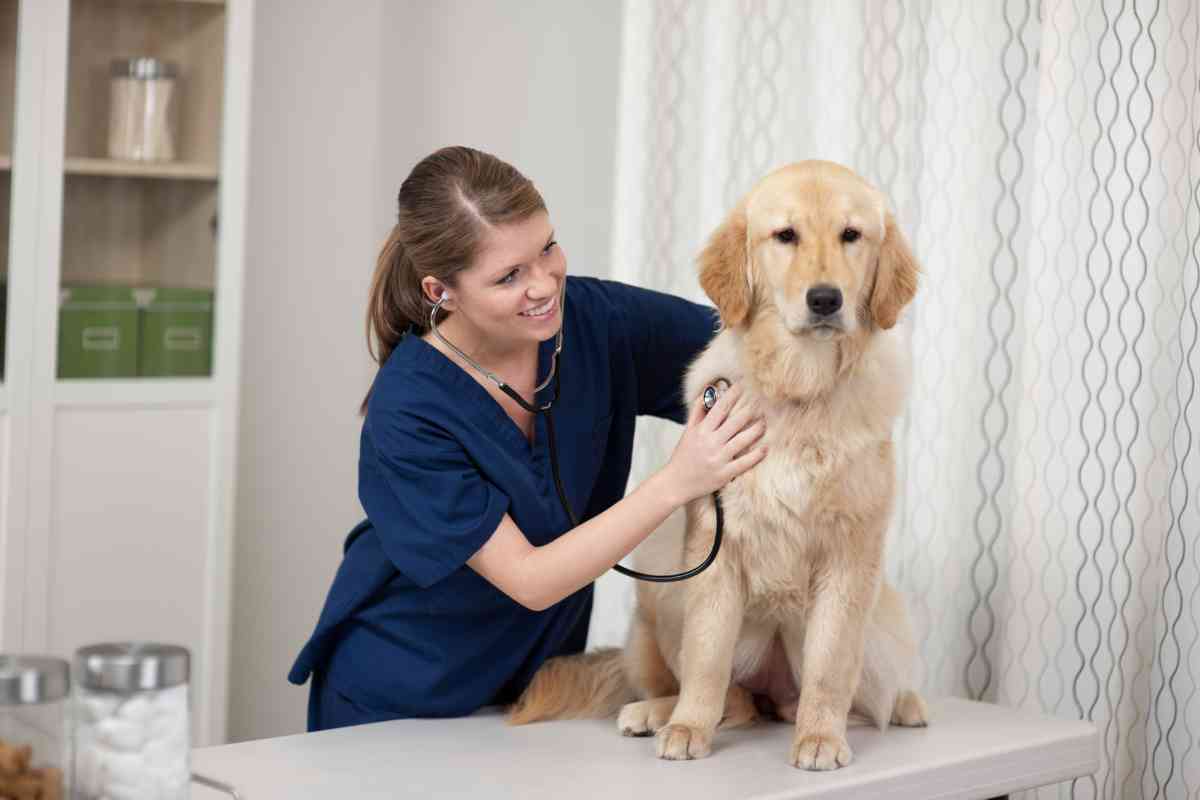
ACL injury
Large breed dogs can tear their ACLs. The ACL is known as the Anterior Crucial Ligament and is found in your Goldendoodle’s knee.
This ligament holds the two bones in your dog’s leg in place and allows your dog to walk correctly. If your Goldendoodle is running or playing very hard, they can easily tear this ligament.
Signs that your dog has torn their ACL are:
- Sudden non-weight bearing lameness
- Pain and inflammation around the knee
- Difficulty standing
- Limping
If you notice any of these signs, it would be best for your dog to see your vet right away. Your vet can examine your dog’s knee and take x-rays to see what is causing these symptoms.
Many times your dog will need to sedate them to be able to fully examine this knee. If your Goldendoodle has torn their ACL, they will have a positive drawer sign in the knee.
This means that your vet can freely move the two-leg bones back and forth. Your dog will most likely have to be sedated for this exam to be done.
What is the Treatment for ACL injuries in Goldendoodles
If your Goldendoodle does have a torn ACL, they will need surgery to correct this issue. There are different orthopedic surgery options depending on the severity of the knee and if there are other issues going on with their knee.
The most common procedure to correct torn ACLs is a tibial plateau leveling osteotomy (TPLO). This surgery will be done by a veterinary surgeon and not your regular veterinarian.
With surgery, your Goldendoodle can usually return to normal after a few months of rest and rehab. There are some things that you can do to help prevent your Goldendoodle from having ACL issues.
Keeping your dog active and fit is the best thing you can do for your Goldendoodle. If your Goldendoodle is overweight, this will cause them to have extra pressure on their joints, leading to many health issues.
Vision Loss
Cataracts
Cataracts in dogs cause opacity of the ocular lens affecting the focusing mechanism for proper vision. The cataract will be found at the front of the retina and behind the pupil, bounded by the colored iris.
A dog who suffers from cataracts is not able to see through the opacity of the lens, if it does not involve the entire lens, partial vision is retained. Sadly, for dogs, cataracts tend to appear in both eyes, often to varying degrees.
The most obvious symptom will involve clouding of the eye, though it should be noted, without the benefit of a trained veterinarian and the proper equipment to evaluate the eye properly a definitive prognosis should not be made.
The treatment for cataracts involves a surgical approach to remove or dissolve the lens.
Currently, the preferred choice of treatment is “phacoemulsification,” a technique that utilizes sound waves to dissolve the structure of the lens while a small suction device removes the broken-down bits.
Once this is successfully accomplished, it is highly advised to place an artificial lens in place, or the pet will be unable to focus and may have difficulty accommodating to a reversal of image projection on the retina.
Costs of Goldendoodle Cataract Surgery
The costs of cataract surgery are high, especially if the recommended lens prosthesis is applied, running $1,500 to $5,000 per eye. Most veterinarians will typically treat one eye, allowing the pet to experience functional vision after surgery.
The best prevention is restricting breeding in affected pets and in first-degree relatives of those pets affected when possible.
Progressive Retinal Atrophy
The most common cause of progressive retinal atrophy is, unfortunately, hereditary. The saddest part about this disorder is that it can be treated but not cured. Once your Goldendoodle has started to lose its sight, it’s only a matter of time before it is completely gone. In some cases, you can expect them to retain their peripheral vision, but not all.
A blind dog can still be a functioning dog, however. You can speak to your vet about what to do for your pup once they have started to lose their vision. You will begin to notice them having some issues with blindness first at night, then during the day. That’s when you’ll know it’s time to visit the doctor.
The Most Common Fatal Goldendoodle Health Issues
Cancer
The Goldendoodle retains one of the highest rates of cancer from its golden retriever half – which is unfortunate. Among health problems, cancer can be relatively easy to catch, but difficult to prevent because it is often tied to genetic problems.
Because cancer is so common in Goldendoodles, we’ve dedicated an entire article about it:
Goldendoodle Cancer: What You Need To Know
Bloat
Gastric Dilation Volvulus is the medical name for bloat. Bloat involves the Goldendoodle’s abdomen filling with air, which causes an increase in pressure that prevents blood from returning to the heart and lungs. The blood then stays in the legs and lower part of the body, starving the rest of the body of needed blood and oxygen.
Strangely enough, the leading cause of bloat seems to be excessive swallowing of air, often associated with eating too fast. As you might suspect, it can be rather difficult to prevent bloat, though it is relatively easy to catch if a dog tries to vomit but can’t, and otherwise is acting strange or restless.
You may have luck slowing your Goldendoodle down while they eat by using one of these anti-gulp food bowls:
This will cause your dog to look very bloated suddenly. This is considered a medical emergency, and you should take your dog to a vet right away.
Commons signs of bloat in dogs are:
- Bloated abdomen
- Difficulty breathing
- Vomiting
- Uncomfortable laying down
This is an emergency situation for Golden Retrievers, Poodles, and Goldendoodles.
If you see any of these signs in your Goldendoodle or suspect that they have developed bloat, you should take your dog to see your vet right away.
If the bloating occurs after hours, you need to go to the emergency vet and not try to wait until the next day your vet is open.
Your vet can quickly examine your Goldendoodle and see if they have developed bloat. Your vet may recommend taking an x-ray. There is a very distinguished pattern that is seen on an x-ray if your dog does have bloat.
How to Treat Bloat
If your Goldendoodle does have bloat, your vet will recommend that your dog has emergency surgery.
Your vet will decompress your Goldendoodle’s stomach are release all the extra air and flip their stomach back into its normal location.
Your vet will also perform a gastropexy to tack the stomach into its normal place to help prevent your dog’s stomach from flipping over again.
Bloat is a life-threatening issue that even with immediate medical attention, your Goldendoodle can pass away from this condition. After surgery, your Goldendoodle will still be in critical condition and need intensive care for a few days to fully recover.
These are a few things that you can do at home to help prevent your Goldendoodle from developing bloat.
- Elevated their bowls for feedings
- Allow them to rest for about 1 hours after eating before exercising
- Use a busy bowls to help slow down eating
These few things may help prevent your Goldendoodle from developing bloat. Sometimes no matter what you do to try to prevent your Goldendoodle from developing bloat, they will still develop bloat.
Subvalvular Aortic Stenosis (Heart Condition)
An inherited cardiovascular condition, aortic stenosis, is commonly found in a variety of large breed dogs. Dogs affected with this disease are born with a heart or aorta too narrow at the site via which the newly oxygenated blood exits as it is pumped to the whole body (from the left ventricle into the aorta). Due to genetic issues, this area can may also become blocked or obstructed by abnormal growths.
Due to the narrow constriction caused by these heart complications, the heart must work harder to pump past this area for the entire body to receive all the oxygen-rich blood required for normal function.
The severity of the narrowing impacts the symptoms experienced by your dog. Some dogs will inherit a mild, barely undetectable narrowing, while others can suffer serious impediments to the outflow of blood from the heart.
Signs that are often consistent with an inability to feed the body the correct amount of blood include the following:
- fainting (due to the brain not receiving the right amount of oxygen)
- poor growth
- exercise intolerance
- sluggishness
Like other diseases common to the Goldendoodle, your dog may not display the above symptoms. However, the secondary effects of a chronically overworked heart will cause the heart to increase in size, causing your dog to develop other symptoms.
The large heart will cause coughing (the heart takes up too much room in the chest), difficulty breathing, and dangerous heart rhythm abnormalities. In extreme cases, sadly, sudden death is another possible outcome for these patients suffering from an enlarged heart.
The best detection for your dog is a comprehensive veterinarian exam.
Identifying this disease is usually accomplished by a heart exam as the vet will be able to detect a heart murmur, a characteristic of this disease.
Once a murmur is detected, most veterinarians will recommend a complete cardiac examination, including a chest X-ray, an electrocardiogram (EKG), and most importantly, an ultrasound of the heart (echocardiogram).
It should be noted a definitive diagnosis always requires an echocardiogram to evaluate the narrowed structures that define the disease.
Unfortunately, the treatment for aortic stenosis in dogs is not up to par with their human counterpart. A few strides have been made in the ability to devise surgical modes of altering the configuration of this delicate area, there is still a long way to go.
Currently, surgeries are not yet considered to be worth their extreme risk, therefore, veterinarians are concentrating their efforts on medical solutions to reducing the impact of the heart’s inevitable work overload.
The main treatments currently center around exercise restrictions and beta-blockers to reduce blood pressure as the blood exits the heart.
The cost of treatment can vary, treating with beta-blocking drugs is a low cost. However, follow-up echocardiograms ranging in price from $500-$600 each can add up over time as you properly treat your dog for this condition.
The only way to achieve a lower incidence of this heart disease is through careful and responsible breeding programs. The ability to easily screen the parents with an echocardiogram before breeding will help ensure the trait has been identified in a future breeding dog’s line.
Experts highly recommend all siblings and parents of affected dogs be spayed and neutered to decrease the incidence of this disease.
A Goldendoodle with subvalvular aortic stenosis can live a long, happy, and healthy life with the right monitoring to ensure that the growth doesn’t become bigger and further block blood flow to the heart.
Addison’s Disease
Hypoadrenocorticism (known as Addison’s Disease) is generally an uncommon disease in dogs (but common in Goldendoodles) where the adrenal glands’ outer layer (the cortex) is destroyed. Often the cause of the destruction is the body’s own immune system causing the destruction of the sensitive endocrine tissue.
When this happens, the production of two classes of hormones: glucocorticoids and mineralocorticoids, is decreased. Additionally, cancer and certain drugs can be a catalyst for this disease as they can break down the adrenal glands’ cortex, ultimately affecting the adrenal glands.
Studies have shown the need for genetic testing is suggested as young female dogs of certain breeds are predisposed, though the mode of inheritance has not yet been established.
Both affected hormones are instrumental in the proper function of a wide variety of the body’s basic functions; therefore, symptoms are typically non-specific. Some symptoms to be aware of include (which can be accelerated during extreme times of stress):
- Increased thirst and urination
- Vomiting, upset stomach, and diarrhea
- Depression
- Weakness
- Loss of appetite
- Shaking or shivering (even collapse can result)
The above symptoms can be constant, episodic, mild or severe, all or none may be evident. Due to the nature of the symptoms, few cases are identified routinely.
Some screening tests (bloodwork) can sometimes help identify the disease if the dog is displaying obvious or severe symptoms. When bloodwork is run, the patients will usually reveal low sodium and chloride levels, high potassium and calcium levels, anemia, and dehydration.
For a definitive diagnosis, an ACTH stimulation test (designed to challenge the adrenal gland into producing cortisol) is used. Additionally, an EKG may reveal changes associated with high potassium levels denoting the possibility of Addison’s disease.
Sadly, the treatment for this disease is usually difficult as most animals are seriously ill by the time the disease is diagnosed, often after suffering Addisonian crisis (acute adrenocortical insufficiency).
Due to the dehydration and electrolyte imbalances that accompany this disease, the severity of the dog’s condition will likely require intensive care, involving fluid therapy and corticosteroids, among other stabilizing drugs, to correct the irregularities and reverse the dog’s symptoms.
The long-term treatment involves drug therapy designed to replace the hormones
The severity of your dog’s condition is a key factor in the cost of veterinary treatment, a typical complete diagnosis can cost between $500 and $1,500 (though the low range does not include an ultrasound).
Dogs requiring intensive care treatment during the diagnostic phase will amass higher costs at a veterinary clinic or emergency care. For these types of care, the costs of treatment can easily total thousands of dollars for diagnosis and intensive care.
The best preventive measure for this disease is genetic testing and removing affected dogs and their first-degree relatives from the breeding pool.
Other Common Goldendoodle Health Problems
Allergies
Most dogs have allergies and Goldendoodles are no exception. Allergies may be more common in doodles with a flatter coat.
Patellar Luxation
More common in a miniature poodle/retriever cross, this kneecap issue can cause lameness, especially if they are overweight. Patellar luxation means that the groove is out of place or weak, leading to more common issues with disclosed knees.
Von Willebrand’s Disease
While the disease tends to be not overly detrimental day to day, moderate to severe forms can make it difficult to stop bleeding once it starts because elements within the Goldendoodle’s blood that allow clots to form simply aren’t there in enough abundance.
A Goldendoodle or Golden Retriever with von Willebrand’s might require both a safe place to play to avoid getting cut and need blood transfusions, which can get quite expensive after a while.
Ear Infections
Floppy ears and wrinkly fur make for easy access for yeast, mites, and other foreign bodies that can sneak into the ear and make it difficult to get them out.
Arthritis
As your dog ages, they may have joint pain. During this time, they will also have weakening of the cartilage of the joints. When the cartilage wears down, eventually, your dog’s bones are rubbing together, creating excessive bony formation.
Signs of arthritis and joint pain in dogs are:
- Limping
- Trouble walking
- Difficulty standing, especially after laying down for a long time
There are many different medications and supplements your veterinarian can prescribe for your dog to help ease their pain. Sometimes there are even surgical options to fix the problem.
Dental disease
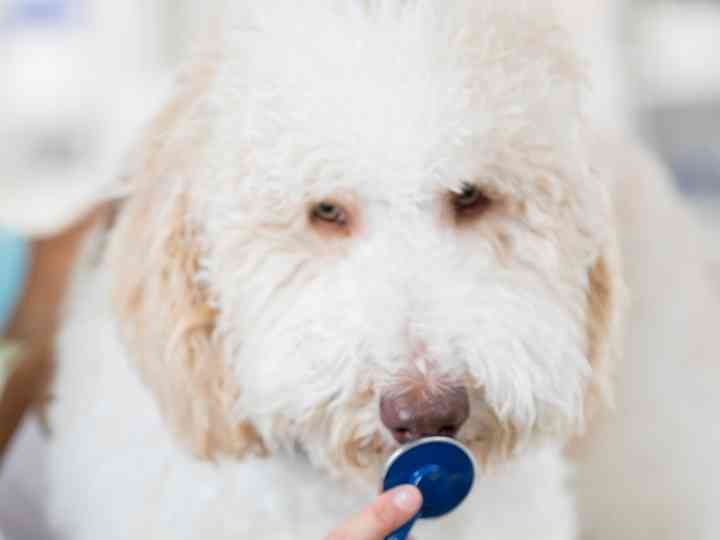
Unless your dog has their teeth brushed twice a day, they will eventually have dental disease. This is the build-up of tartar on your dog’s teeth, which causes their bad breath.
Small and toy Goldendoodles are very prone to dental disease and will need routine dental cleanings. Signs that your dog has dental problems are:
- Bad smelling breath
- Drooling
- Difficulty eating
- Swollen face right under the eye
You can also see if your dog has dental disease by looking at your dog’s teeth. You will be able to see the tartar build-up on their teeth.
Prevention of dental disease
After your veterinarian cleans your dog’s teeth, there are many things that you can do to help prevent dental disease. These are:
- Dental chews
- Additives for their water
- Brushing their teeth daily
Gastrointestinal Issues
There are many signs that your dog can display that indicate they are having gastrointestinal issues like:
- Vomiting
- Diarrhea
- Drooling
- Not eating
- Bloody or mucus in their stool
While these signs can point to many different diseases, these are some of the most common reasons that a dog will have gastrointestinal issues:
- Pancreatitis – This is an inflammation of the pancreas, usually from eating a fatty meal
- Obstruction
- Parasites
- Dietary indiscretion
- Organ failure
Your veterinarian can test for underlying disease and get your dog on the best treatment for their gastrointestinal issue.
Obesity
If your pet has put on a few extra pounds, this can lead to many other medical issues such as:
- Joint pain and arthritis
- Heart issues
- Liver and kidney issues
- Difficulty breathing
If your dog is overweight, you can help them lose weight by increasing their exercise and decreasing the amount of food that you are feeding them. There are also low-fat diets that are specifically designed to help your dog lose weight.
Epilepsy
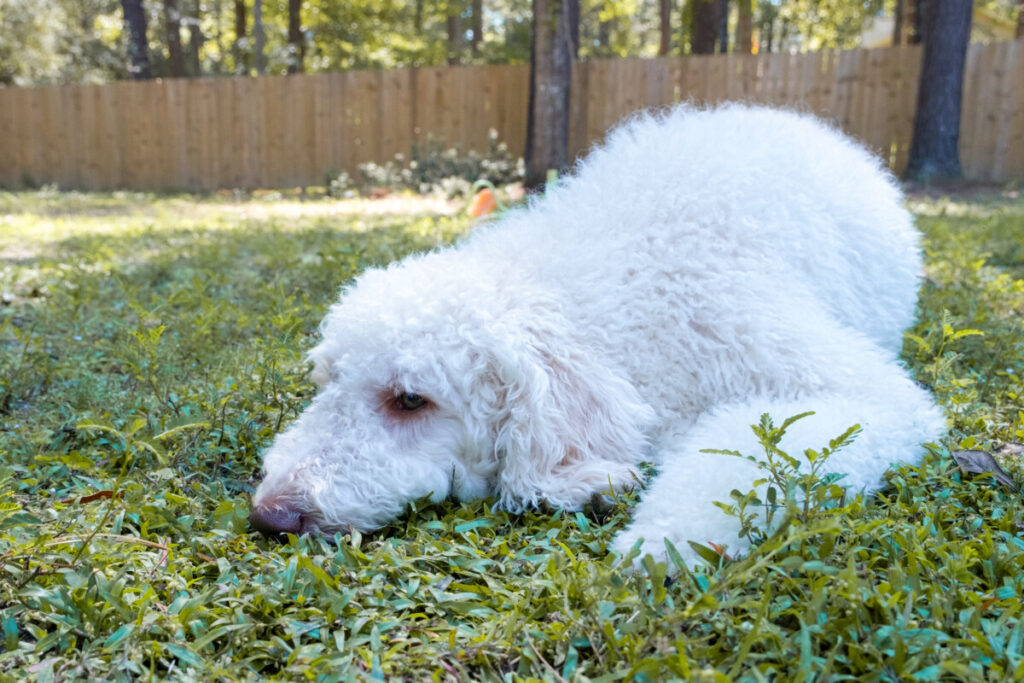
Epilepsy is when your dog has a series of uncontrollable, spiked electrical activities which target the nervous system (one seizure is not enough to signify epilepsy and is more likely indicative of your dog having ingested poison, having a head injury, or something similar).
You will know your dog is having a seizure if they collapse, foam at the mouth, make paddling motions with their legs, thrash around, or a combination of these things. They will not be aware of their surroundings when this happens. You will need to take your dog to their vet right away so you can learn what to do when these seizures occur.
Heart Disease
Older dogs can suffer from heart disease. As they age, their heart no longer beats effectively. There are many different types of heart disease, depending on what part of the heart is not working. Typical signs associated with heart disease are:
- Coughing
- Trouble breathing
- Collapsing episodes
- Fluid in chest or abdomen
Your veterinarian can listen to your dog’s heart and lungs to see if they have a heart murmur. If your dog does show signs of heart disease, many tests may have to be done, including chest x rays, an Echocardiogram (ultrasound of the heart), and EKG. These tests will help your veterinarian determine how progressed the disease is.
How To Choose A Healthy Goldendoodle Puppy
To help make life easier for your new puppy, it is important to stress the below 5 tips recommended for new owners when choosing a healthy Goldendoodle puppy.
- Finding a good breeder who can supply health certifications necessary to screen out health problems is more important than finding the right puppy. A good start for your search is the Goldendoodle Association of North America.
- Consider adopting an adult dog from a rescue or shelter. Since many diseases can start when they are a puppy, if you adopt an adult dog, you can rule out health problems.
- Whether you obtain a puppy or adult dog, be sure to take them to your veterinarian for a complete examination.
- It is recommended you never buy a puppy from a pet store as your chances of getting an unhealthy, unsocialized, and difficult to housetrain puppy are likely.
- Make sure you have a good contract with the seller, shelter, or rescue group detailing responsibilities on both sides. Understand your rights and recourses.
Ensure your Goldendoodle has a better chance at a healthy life and a longer life expectancy by knowing the breeder you are choosing and the health history of the parents.
It is highly recommended you should never purchase a puppy from a breeder who cannot provide you with written documentation ensuring the parents were cleared of health problems common to their specific breed. Avoid a puppy mill at all costs.
Although it is a great idea to have your dog checked by your veterinarian, this does not replace the need for genetic health testing.
Most importantly, enjoy and take good care of your new family member. A whole new journey awaits with your new best friend.
Related Content You May Find Interesting
Here are some more articles that may be of interest to you if you’re concerned about Goldendoodle health issues.
- Goldendoodles are a crossbreed between a purebred Golden Retriever and a Poodle, inheriting traits from both breeds.
- They are intelligent, friendly, and affectionate, making them popular among dog owners.
- However, they are prone to developing hereditary genetic health problems from their parent breeds.
- The five most common diseases Goldendoodles are prone to are hip dysplasia, sebaceous adenitis, subvalvular aortic stenosis, Addison’s disease, and cataracts.
- The best way to prevent these diseases is to get a puppy from a good and reputable breeder who provides all necessary health certifications and genetic testing.
- Hip dysplasia is a genetic orthopedic disease that causes changes in the hip joint, leading to arthritis and causing pain and discomfort. Symptoms may not be obvious, so regular checkups with a veterinarian are crucial.
- To prevent hip dysplasia, it is important to feed your Goldendoodle a balanced diet, not overfeed, and avoid over-exercising. Regular visits to the vet and X-rays can help detect the condition early on.
- Sebaceous adenitis is a hereditary skin disease that causes inflammation in the sebaceous glands, leading to hair loss and scaly skin. It is most likely inherited in predisposed breeds such as the standard poodle.
